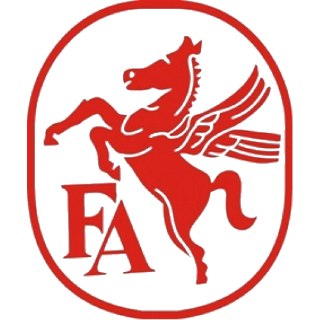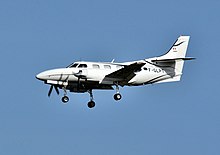Fairchild Aviation Swearingen Merlin IIB
|
|||||||
|---|---|---|---|---|---|---|---|
| Manufacturer | Swearingen Fairchild Aircraft |
||||||
| Designer | Ed SwearingenJohn T. Jennings | ||||||
| First flight | 13 April 1965 | ||||||
| Status | Out of production, in service | ||||||
| Produced | 1965-1998 | ||||||
| Variants | Fairchild Swearingen Metroliner C-26 Metroliner |
||||||
.
History Fairchild Aviation Corporation.
Swearingen Merlin
First flight 13 April 1965
Produced 1965-1998

The Swearingen Merlin or the Fairchild Aerospace Merlin is a pressurized, twin turboprop business aircraft first produced by Swearingen Aircraft, and later by Fairchild at a plant in San Antonio, Texas.
The Merlin was an evolution of earlier modification programs performed by Swearingen Aircraft. Ed Swearingen started the developments that led to the Merlin through gradual modifications to the Beechcraft Twin Bonanza and Queen Air business aircraft which he dubbed Excalibur. Then a hybrid aircraft was developed, with a new fuselage and vertical fin, mated to salvaged and modified (wet) Queen Air wings and horizontal tails, and Twin Bonanza landing gear: the Merlin.
Variants
Straight-wing variants

SA26T Merlin IIB The SA226-TC Metro was more-or-less a new design, conceptually a stretch of the Merlin II (which it superficially resembled) sized to seat 22 passengers. Prototype construction of the Metro began in 1968 and first flight was on 26 August 1969. The standard engines offered were two TPE331-3UW turboprops driving three-bladed propellers. A corporate version called the SA226-AT Merlin IV was also marketed and initially sales of this version were roughly double that of the Metro. These sales were not immediately forthcoming however, as the company was financially stretched by the development of the Metro prototype and lacked the funds to gear up for production. This situation was rectified in late 1971 when Ed Swearingen agreed to sell 90% of the company to Fairchild; the company was then renamed Swearingen Aviation Corporation.
By the end of 1972 six Merlin IVs had been built and production gradually built up alongside the concurrently produced short-fuselage Merlin III. In 1974, the original Merlin IV and Metro models were replaced by the SA226-AT Merlin IVA and the SA226-TC Metro II after about 30 Merlin IVs and about 20 Metros had been built. Among the changes made were larger, ovalised rectangular windows replacing the circular porthole-style windows of the early aircraft, and optional provision for a small Rocket-Assisted Take Off (RATO) rocket in the tail cone, this being offered to improve takeoff performance out of "hot & high" airfields. The same year the Merlin III was replaced by the SA226-T Merlin IIIA, with an extra window on the right side of the cabin and a small window aft of the airstair on each side of the fuselage. Customers for the Merlin IIIA included the Argentinian Air Force, the Argentine Army and the Belgian Air Force.

Merlin IIIA
0
KmCeiling
0
KmCombat RANGE
0
Km/hAircraft Speed
0
Max Crew
Photo Gallery
Fairchild Aviation Corporation.
Swearingen Merlin IIB


Fairchild Aviation Corporation. Originally known as the Seversky Aircraft Company
Swearingen Merlin IIB
General Info
-
-
- Crew: 2
- Capacity: up to 9 passengers
- Length: 42 ft 2 in (12.85 m)
- Wingspan: 46 ft 3 in (14.10 m)
- Height: 16 ft 10 in (5.13 m)
- Wing area: 277.5 sq ft (25.78 m2)
-
Powerplant
-
- Empty weight: (3,697 kg)
- Max takeoff weight: (6,001 kg)
- Fuel capacity: 2,450 L)
- Powerplant: 2 × Garrett AiResearch TPE-331-10U-503G turboprops [18], 900 shp (670 kW) each
- Propellers: 4-bladed Dowty Type R.321, 8 ft 10 in (2.69 m) diameter
-
Performance
- Cruise speed: 300 kn (350 mph, 560 km/h) at 10,000 ft (3,050 m) (max cruise)
- Stall speed:(106 mph, 170 km/h) (flaps and landing gear down)
- Range: 1,938 nmi (2,230 mi, 3,589 km) at 26,000 ft (7,900 m), six occupants
- Ferry range: 2,239 nmi (2,577 mi, 4,147 km)
- Service ceiling: (8,200 m)
Aircraft of comparable role, configuration, and era
.
Links to Youtube & Others
The Swearingen Merlin or the Fairchild Aerospace Merlin is a pressurized, twin turboprop business aircraft first produced by Swearingen Aircraft, and later by Fairchild at a plant in San Antonio, Texas.
Fairchild Aviation Swearingen Merlin
The Merlin was an evolution of earlier modification programs performed by Swearingen Aircraft.
Youtube Link
The Australian Department of Civil Aviation (now the Civil Aviation Safety Authority) took delivery of four Merlin IIBs in 1969 and operated them for almost fifteen years














